I might not have been up at first light Thursday morning but it was close. Armed with my camera, my site list, and a determination to proceed apace, I set out from the hotel making my first return to Mirabell Garden. I started early to provide the opportunity to take as many unpeopled photos as possible. Sometimes I can crop a photo that has an unwanted person or object and still retain the essence of the image. But not always. So, rather than engaging in editing, the early morning presents a better opportunity for a “personless” moment.
Spoiler Alert
I shouldn’t need to note that I am a big fan of the movie The Sound of Music just as I deeply admire Amadeus and Chariots of Fire. None of these films intend to be documentaries and all serve a purpose far beyond recreating historical events but I’m pedantic and I think their purpose is better understood when we know the reality. Thus, the closing section of this post will detail some of the many elements that the movie simply has wrong. I’ll first go through my pictures (taken over both days). If you read beyond that, consider yourself warned.
I Have Confidence
The only places I was able to see that appear during Maria’s song I Have Confidence were the Rezidenzplatz and the Kapitelplatz. The Rezidenzplatz appears twice in song and is seen from different angles. I’ve pulled this screen capture from the first
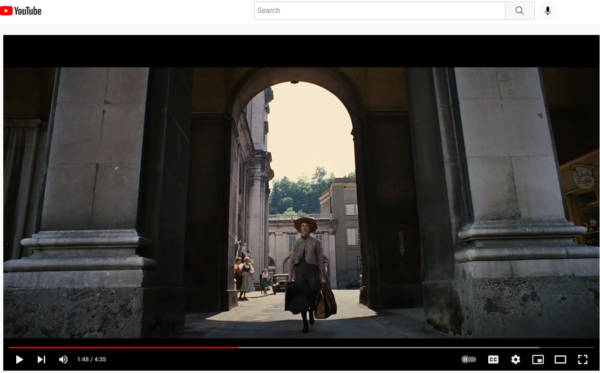
because the woman in the blue top in the background is Maria von Trapp. I have two shots of these arches – one from close to the real Maria’s viewpoint
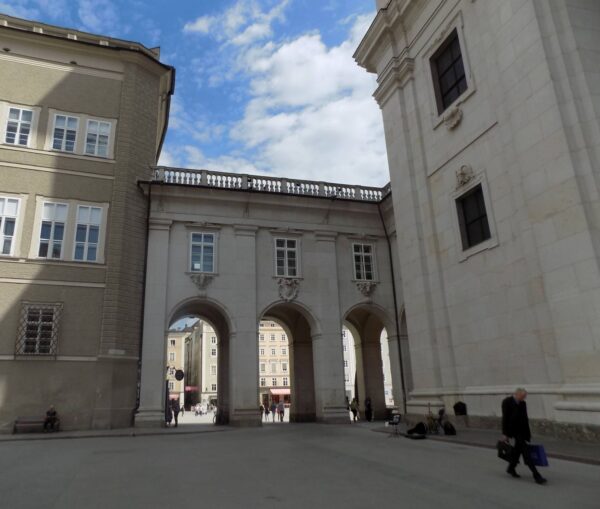
and one more or less from the camera’s.
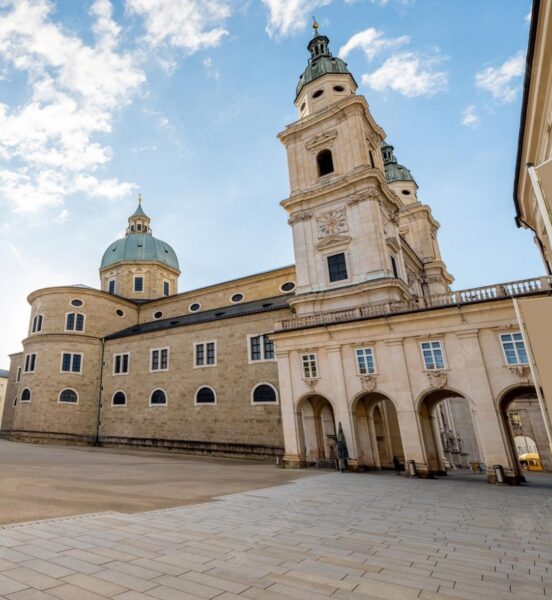
The musical Maria walks through the arches and is next seen standing near the fountain that’s actually to her right (or this position’s left.)
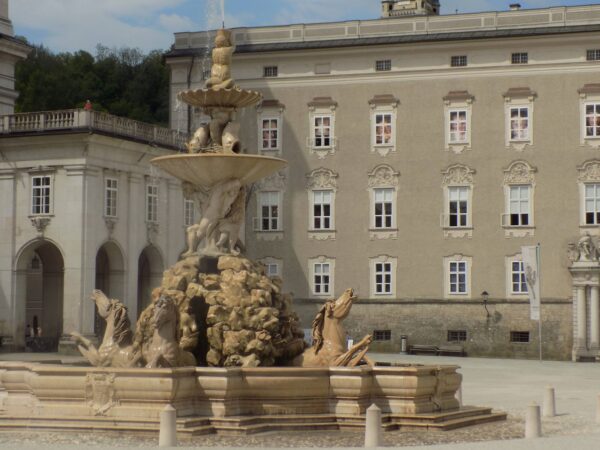
The time stamps for these spots in the clip below are 1:48 and 2:02. The Residenzplatz reappears later in the movie when Nazi soldiers march into Salzburg during the Anschluss.
My final shot from this song is of the Kapitelplatz and Kapitalschwemme that comes in at 2:28 and is glimpsed from a greater distance than in my photo.
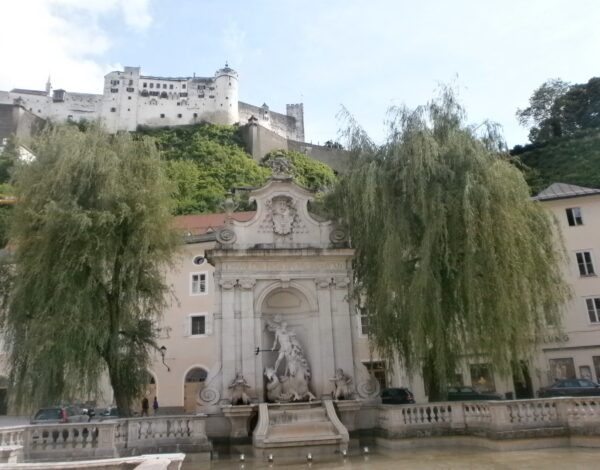
Shortly after leaving the abbey, you see Maria standing at a point that overlooks Salzburg. It’s called the Winkler Terrace and is more than a kilometer from the Nonberg Abbey. I didn’t get there. Meanwhile, here’s the clip.
My Favorite Things Instrumental Reprise
Curtains become play clothes and Maria and the children do some shopping. I didn’t reach the Kajetanerplatz where Maria pretends to juggle tomatoes and I somehow missed the Domplatz (though you see the towers of the cathedral in a number of photos) but I did grab shots of the Mozartsteg

(albeit looking rather different nearly 60 years later) and the Pferdeschwimmer (Horse Bath)
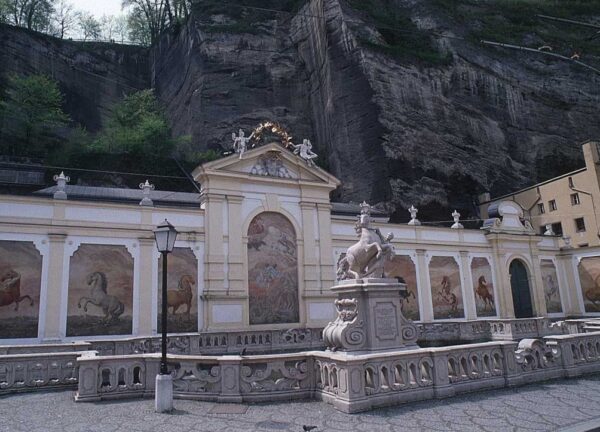
visible at 40 seconds. The video owner has disabled playback on other sites so here’s a link.
Do-Re-Mi
Now we come to Mirabell Garden. The first shot here is of Maria and the children marching around the Pegasus Fountain (0:58),

then skipping and running through the arched arbor,
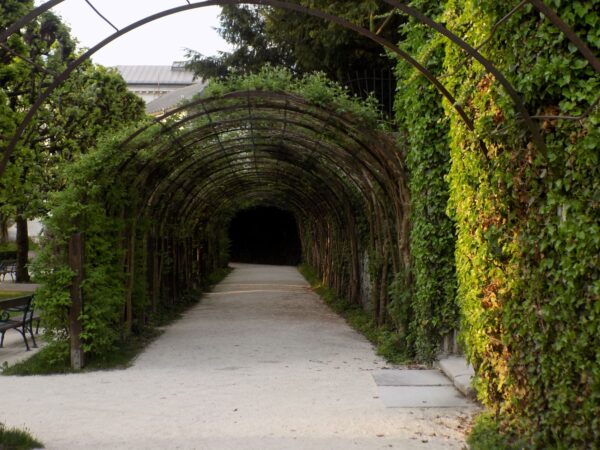
at one of the entrances to the garden,

followed by passing this fountain
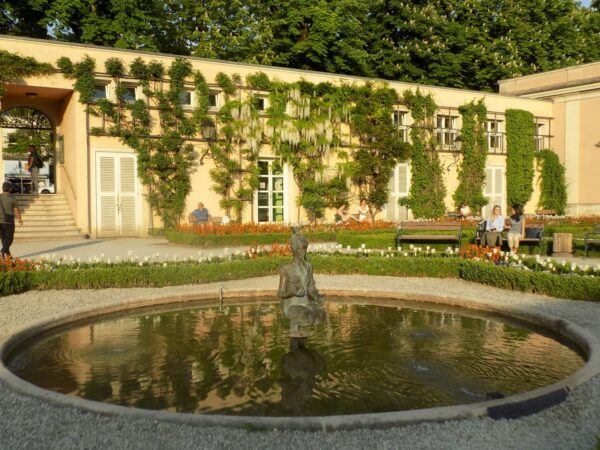
(shot from the opposite side and not in full spray). From there they are in the Dwarf Garden in front of this fellow

before finishing up here.

You can watch for yourselves:
The rest of the story
Wrong from the start
Even when drawing on historical events, movies need to move. Movies need to tell a story and ofttimes it’s the story that the writer wants to tell. This was the case with Amadeus (that I’ve discussed in part elsewhere on this trip) and it was true of Chariots of Fire that I wrote about in this post). Now I’ll deconstruct The Sound of Music.
Maria Kutschera did, indeed, leave Nonberg Abbey to work for Captain Georg von Trapp whom she eventually married – on 26 November 1927. In poor health herself, she entered the von Trapp household in 1926 for what was intended as a 10-month engagement to use her training at Vienna’s State Teachers College for Progressive Education to become a tutor to Georg’s oldest daughter – also named Maria – who had fallen ill with scarlet fever and could no longer attend school. So, tutor to one not governess to all though, in her memoir, Maria revealed that she, “…really and truly was not in love. I liked him, but didn’t love him. However, I loved the children, so in a way, I really married the children.”
By the time frame of the film, Maria (seen here in a 1940 photograph)
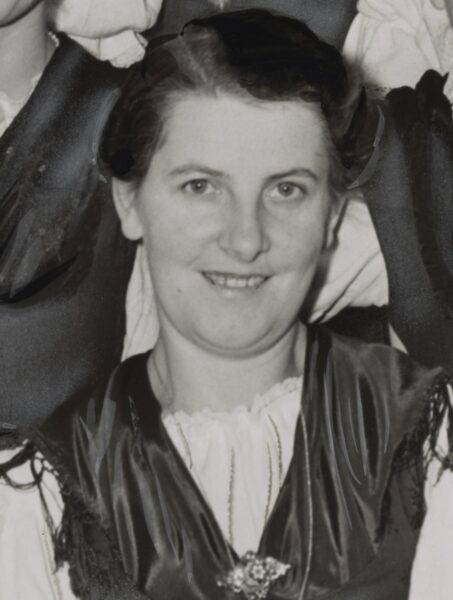
(Wikimedia Commons – Unattributed)
had been Baroness von Trapp for more than a decade, had borne the Captain two children and was pregnant with a third. In actuality, there were 10 von Trapp children and while Maria taught them traditional songs and how to yodel, they were singing before she joined their household.
Personality disorder
Years before the Broadway musical and movie, Maria had sold the rights to the family’s story and while they received some royalties, they had very little input into the film’s portrayals. (The musical was based largely on the original film, Die Trapp-Familie.) Among the elements that upset the children most was portraying their father as a drillmaster who was a rigorous disciplinarian though he did use the whistle and dress his children in sailor suits.
In his book The Sound of Music Story Tom Santopietro wrote that in reality, though Georg was a retired naval officer, he was also a warm and loving if somewhat overwhelmed father. Rather it was Maria, who had been orphaned at a young age and was raised by a reportedly abusive uncle, who could be emotionally distant. In a 2003 interview with the BBC, Johannes, the youngest son who was born in Philadelphia, described his father as, “a very charming man, generous, open, and not the martinet he was made out to be both in the stage play and in the film. My mother did try to alter that portrayal for the film, but she was not successful.”
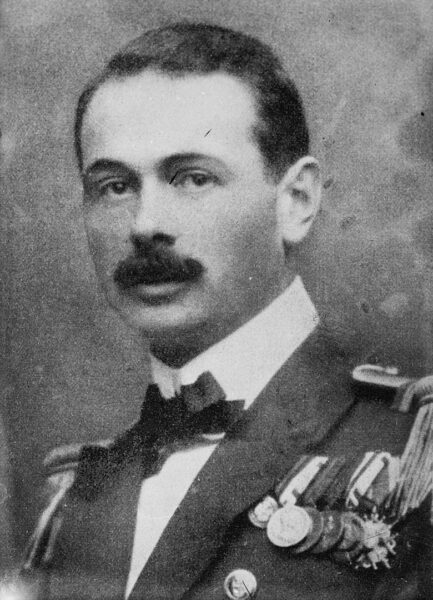
(Wikimedia Commons – Public Domain)
Maria, on the other hand, wasn’t quite the forbearing angel portrayed by Julie Andrews. Maria herself told the Washington Post in a 1978 interview that both Mary Martin (who portrayed her in the original Broadway production) and Julie Andrews were, “too gentle – like girls out of Bryn Mawr.” And in 2003, the younger Maria described her stepmother as having, “a terrible temper. And from one moment to the next, you didn’t know what hit her. We were not used to this. But we took it like a thunderstorm that would pass, because the next minute she could be very nice.”
Not Uncle Max but Father Franz
When the Great Depression stripped the von Trapp family of most of their wealth in the 1930s, they took in boarders to help make ends meet. One of those was Father Franz Wasner. It was he who recognized their talent and crafted them into professional singers. The younger Maria told Santopietro, “He slowly but surely molded us into a real musical entity,” and Santopietro calls Wasner, “the driving musical force behind the Trapp Family Singers.”

(From clickamericana)
Not over the Alps
While the family’s final escape, intending to reach Switzerland by climbing evr’y mountain while carrying their belongings, creates real drama and excellent visual cinema, it would have been foolhardy for them to attempt that exit. Had they started in that manner and direction,
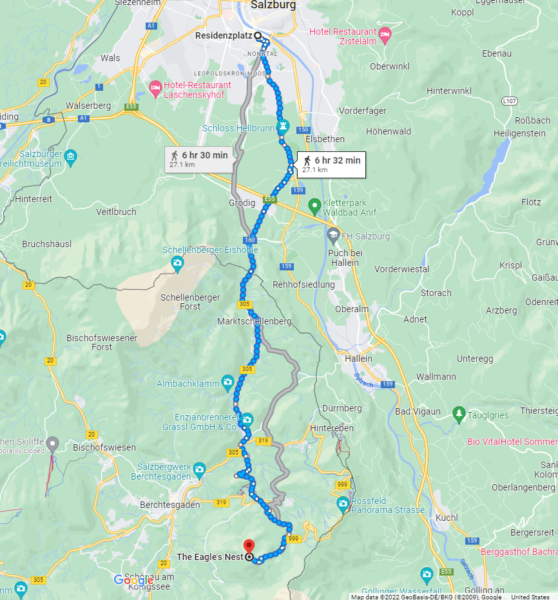
they probably wouldn’t have gotten very far.
In truth, though he was openly at odds with the Nazis and did refuse to fly their flag, they didn’t make leaving an easy choice. They offered the financially troubled von Trapps enticements including greater fame as a singing group, a medical doctor’s position for their oldest son Rupert, and a renewed naval career for Georg.
They had to weigh these temptations and opportunities against the risk of leaving behind everything they knew for an unforeseeable future. It’s possible that Maria’s pregnancy was an added consideration. In the end they decided they couldn’t compromise their principles. They boarded a train for Italy where the family had citizenship because Captain von Trapp’s birthplace (what is now Zadar, Croatia) became Italian territory under the treaty of Rapallo in 1920. The real drama in their escape was that had they waited even a single day longer they would have been von trapped. The Germans closed the borders the day after the von Trapps boarded that train.
I’ll be back with the group in tomorrow’s post that will begin with a walking tour of Salzburg. Meanwhile, here’s a link to the handful of photos not in this post.
And, here’s a pair of bonus videos for other SoM fans. In the first, some of the cast reunite in Salzburg for a 50th anniversary celebration.
In the second, my rebroadcast of the five living actors who played the children helping Julie Andrews celebrate her AFI Life Achievement Award.